Organisational Behaviour Report: Tesco Case Study Analysis
VerifiedAdded on 2020/12/18
|8
|2028
|382
Report
AI Summary
This report delves into the realm of organisational behaviour, using Tesco as a case study to illustrate key concepts. It begins by differentiating between effective and ineffective teams, highlighting the characteristics that contribute to each. The report then explores the application of organisational behaviour philosophies, specifically focusing on path-goal theory and Maslow's hierarchy of needs, to understand how leaders can motivate employees and guide them towards achieving organisational goals. Different leadership styles, such as supportive, directive, participative, and achievement-oriented leadership, are discussed in the context of their impact on employee performance. The report also touches upon Tuckman's theory of team development, providing insights into how teams evolve and how managers can facilitate this process. The overall aim is to provide a comprehensive overview of how organisational behaviour principles can be applied to enhance team performance and achieve organisational success, using Tesco as a practical example. This report serves as a valuable resource for students studying leadership and management, providing real-world examples and actionable insights.
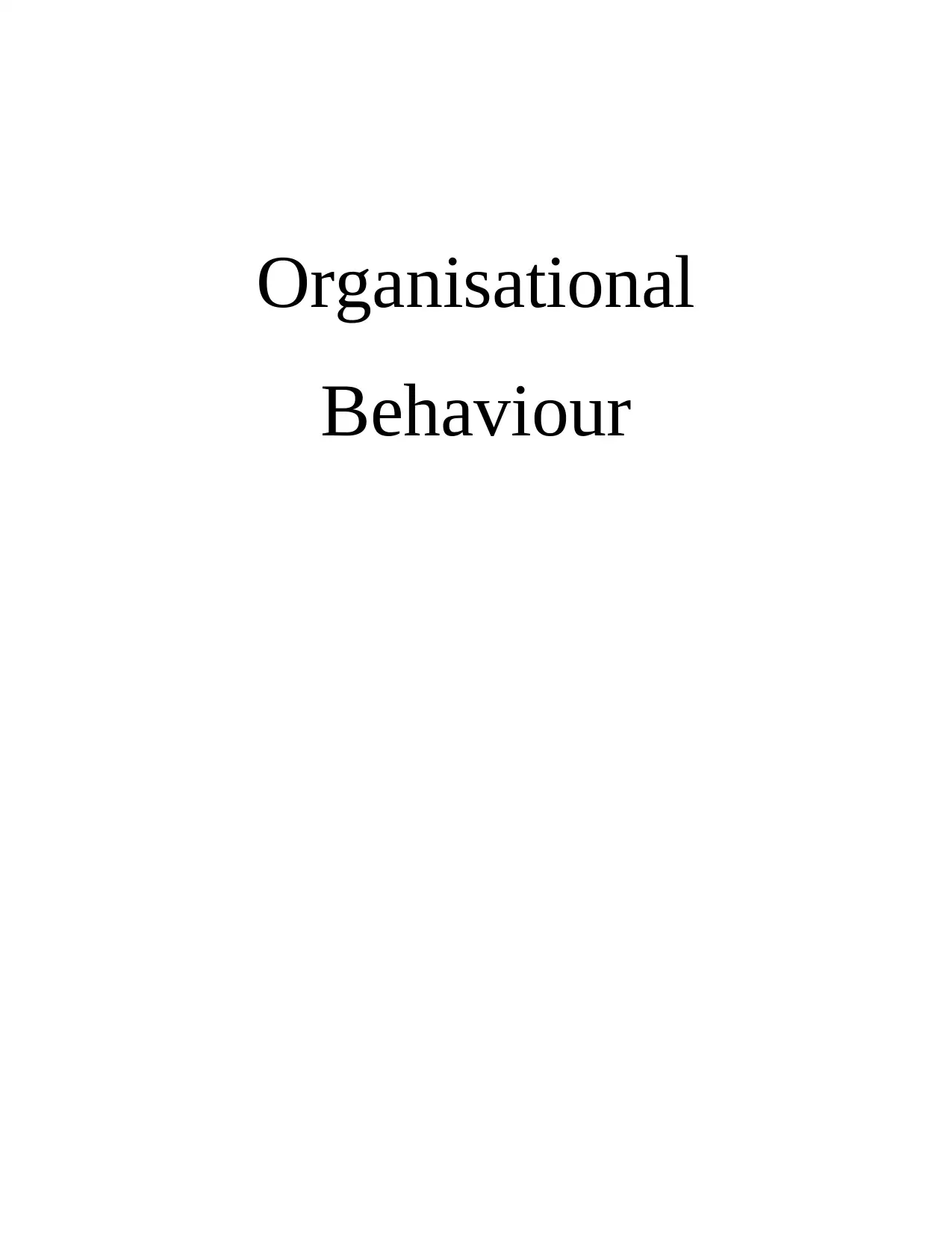
Organisational
Behaviour
Behaviour
Paraphrase This Document
Need a fresh take? Get an instant paraphrase of this document with our AI Paraphraser
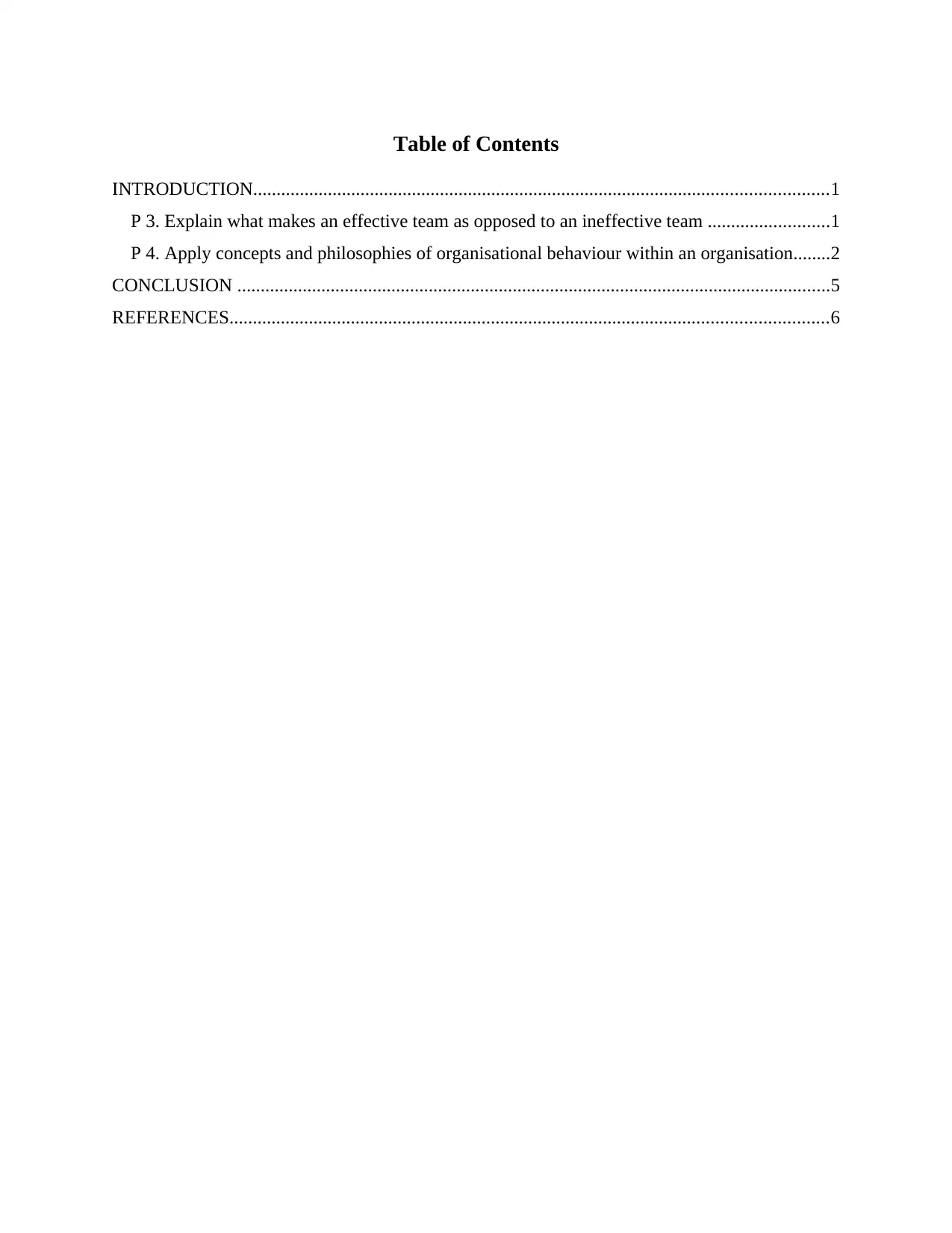
Table of Contents
INTRODUCTION...........................................................................................................................1
P 3. Explain what makes an effective team as opposed to an ineffective team ..........................1
P 4. Apply concepts and philosophies of organisational behaviour within an organisation........2
CONCLUSION ...............................................................................................................................5
REFERENCES................................................................................................................................6
INTRODUCTION...........................................................................................................................1
P 3. Explain what makes an effective team as opposed to an ineffective team ..........................1
P 4. Apply concepts and philosophies of organisational behaviour within an organisation........2
CONCLUSION ...............................................................................................................................5
REFERENCES................................................................................................................................6
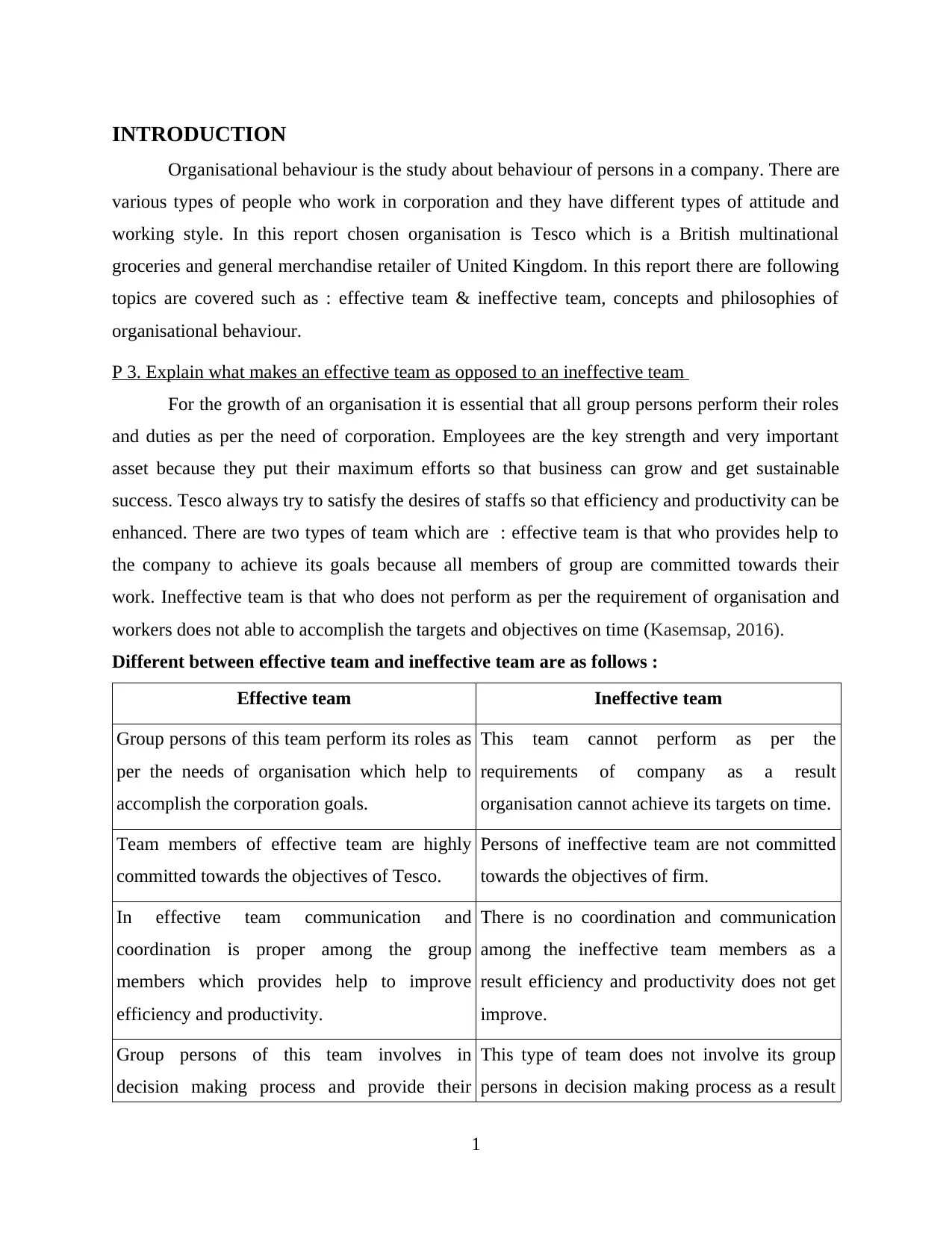
INTRODUCTION
Organisational behaviour is the study about behaviour of persons in a company. There are
various types of people who work in corporation and they have different types of attitude and
working style. In this report chosen organisation is Tesco which is a British multinational
groceries and general merchandise retailer of United Kingdom. In this report there are following
topics are covered such as : effective team & ineffective team, concepts and philosophies of
organisational behaviour.
P 3. Explain what makes an effective team as opposed to an ineffective team
For the growth of an organisation it is essential that all group persons perform their roles
and duties as per the need of corporation. Employees are the key strength and very important
asset because they put their maximum efforts so that business can grow and get sustainable
success. Tesco always try to satisfy the desires of staffs so that efficiency and productivity can be
enhanced. There are two types of team which are : effective team is that who provides help to
the company to achieve its goals because all members of group are committed towards their
work. Ineffective team is that who does not perform as per the requirement of organisation and
workers does not able to accomplish the targets and objectives on time (Kasemsap, 2016).
Different between effective team and ineffective team are as follows :
Effective team Ineffective team
Group persons of this team perform its roles as
per the needs of organisation which help to
accomplish the corporation goals.
This team cannot perform as per the
requirements of company as a result
organisation cannot achieve its targets on time.
Team members of effective team are highly
committed towards the objectives of Tesco.
Persons of ineffective team are not committed
towards the objectives of firm.
In effective team communication and
coordination is proper among the group
members which provides help to improve
efficiency and productivity.
There is no coordination and communication
among the ineffective team members as a
result efficiency and productivity does not get
improve.
Group persons of this team involves in
decision making process and provide their
This type of team does not involve its group
persons in decision making process as a result
1
Organisational behaviour is the study about behaviour of persons in a company. There are
various types of people who work in corporation and they have different types of attitude and
working style. In this report chosen organisation is Tesco which is a British multinational
groceries and general merchandise retailer of United Kingdom. In this report there are following
topics are covered such as : effective team & ineffective team, concepts and philosophies of
organisational behaviour.
P 3. Explain what makes an effective team as opposed to an ineffective team
For the growth of an organisation it is essential that all group persons perform their roles
and duties as per the need of corporation. Employees are the key strength and very important
asset because they put their maximum efforts so that business can grow and get sustainable
success. Tesco always try to satisfy the desires of staffs so that efficiency and productivity can be
enhanced. There are two types of team which are : effective team is that who provides help to
the company to achieve its goals because all members of group are committed towards their
work. Ineffective team is that who does not perform as per the requirement of organisation and
workers does not able to accomplish the targets and objectives on time (Kasemsap, 2016).
Different between effective team and ineffective team are as follows :
Effective team Ineffective team
Group persons of this team perform its roles as
per the needs of organisation which help to
accomplish the corporation goals.
This team cannot perform as per the
requirements of company as a result
organisation cannot achieve its targets on time.
Team members of effective team are highly
committed towards the objectives of Tesco.
Persons of ineffective team are not committed
towards the objectives of firm.
In effective team communication and
coordination is proper among the group
members which provides help to improve
efficiency and productivity.
There is no coordination and communication
among the ineffective team members as a
result efficiency and productivity does not get
improve.
Group persons of this team involves in
decision making process and provide their
This type of team does not involve its group
persons in decision making process as a result
1
⊘ This is a preview!⊘
Do you want full access?
Subscribe today to unlock all pages.

Trusted by 1+ million students worldwide
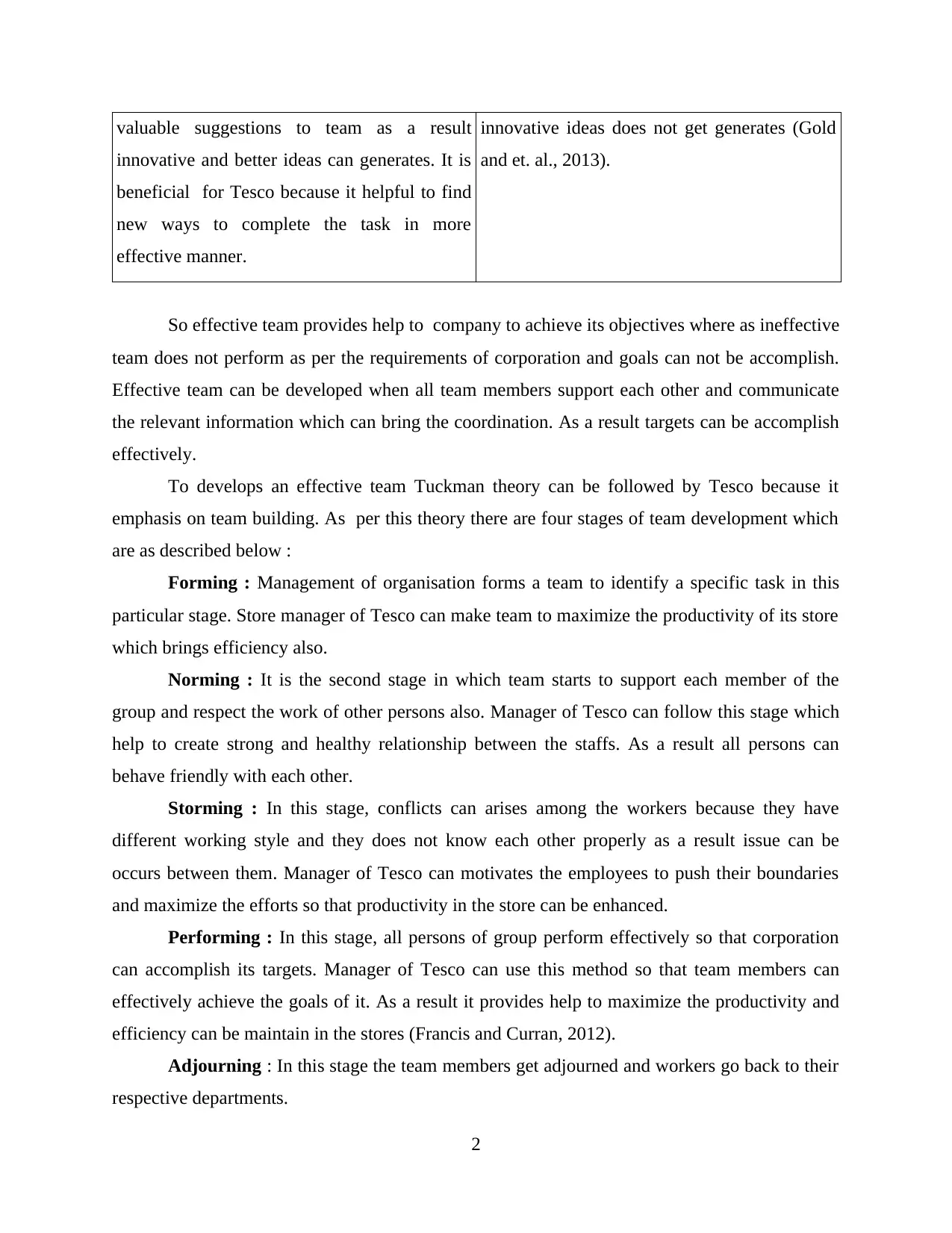
valuable suggestions to team as a result
innovative and better ideas can generates. It is
beneficial for Tesco because it helpful to find
new ways to complete the task in more
effective manner.
innovative ideas does not get generates (Gold
and et. al., 2013).
So effective team provides help to company to achieve its objectives where as ineffective
team does not perform as per the requirements of corporation and goals can not be accomplish.
Effective team can be developed when all team members support each other and communicate
the relevant information which can bring the coordination. As a result targets can be accomplish
effectively.
To develops an effective team Tuckman theory can be followed by Tesco because it
emphasis on team building. As per this theory there are four stages of team development which
are as described below :
Forming : Management of organisation forms a team to identify a specific task in this
particular stage. Store manager of Tesco can make team to maximize the productivity of its store
which brings efficiency also.
Norming : It is the second stage in which team starts to support each member of the
group and respect the work of other persons also. Manager of Tesco can follow this stage which
help to create strong and healthy relationship between the staffs. As a result all persons can
behave friendly with each other.
Storming : In this stage, conflicts can arises among the workers because they have
different working style and they does not know each other properly as a result issue can be
occurs between them. Manager of Tesco can motivates the employees to push their boundaries
and maximize the efforts so that productivity in the store can be enhanced.
Performing : In this stage, all persons of group perform effectively so that corporation
can accomplish its targets. Manager of Tesco can use this method so that team members can
effectively achieve the goals of it. As a result it provides help to maximize the productivity and
efficiency can be maintain in the stores (Francis and Curran, 2012).
Adjourning : In this stage the team members get adjourned and workers go back to their
respective departments.
2
innovative and better ideas can generates. It is
beneficial for Tesco because it helpful to find
new ways to complete the task in more
effective manner.
innovative ideas does not get generates (Gold
and et. al., 2013).
So effective team provides help to company to achieve its objectives where as ineffective
team does not perform as per the requirements of corporation and goals can not be accomplish.
Effective team can be developed when all team members support each other and communicate
the relevant information which can bring the coordination. As a result targets can be accomplish
effectively.
To develops an effective team Tuckman theory can be followed by Tesco because it
emphasis on team building. As per this theory there are four stages of team development which
are as described below :
Forming : Management of organisation forms a team to identify a specific task in this
particular stage. Store manager of Tesco can make team to maximize the productivity of its store
which brings efficiency also.
Norming : It is the second stage in which team starts to support each member of the
group and respect the work of other persons also. Manager of Tesco can follow this stage which
help to create strong and healthy relationship between the staffs. As a result all persons can
behave friendly with each other.
Storming : In this stage, conflicts can arises among the workers because they have
different working style and they does not know each other properly as a result issue can be
occurs between them. Manager of Tesco can motivates the employees to push their boundaries
and maximize the efforts so that productivity in the store can be enhanced.
Performing : In this stage, all persons of group perform effectively so that corporation
can accomplish its targets. Manager of Tesco can use this method so that team members can
effectively achieve the goals of it. As a result it provides help to maximize the productivity and
efficiency can be maintain in the stores (Francis and Curran, 2012).
Adjourning : In this stage the team members get adjourned and workers go back to their
respective departments.
2
Paraphrase This Document
Need a fresh take? Get an instant paraphrase of this document with our AI Paraphraser
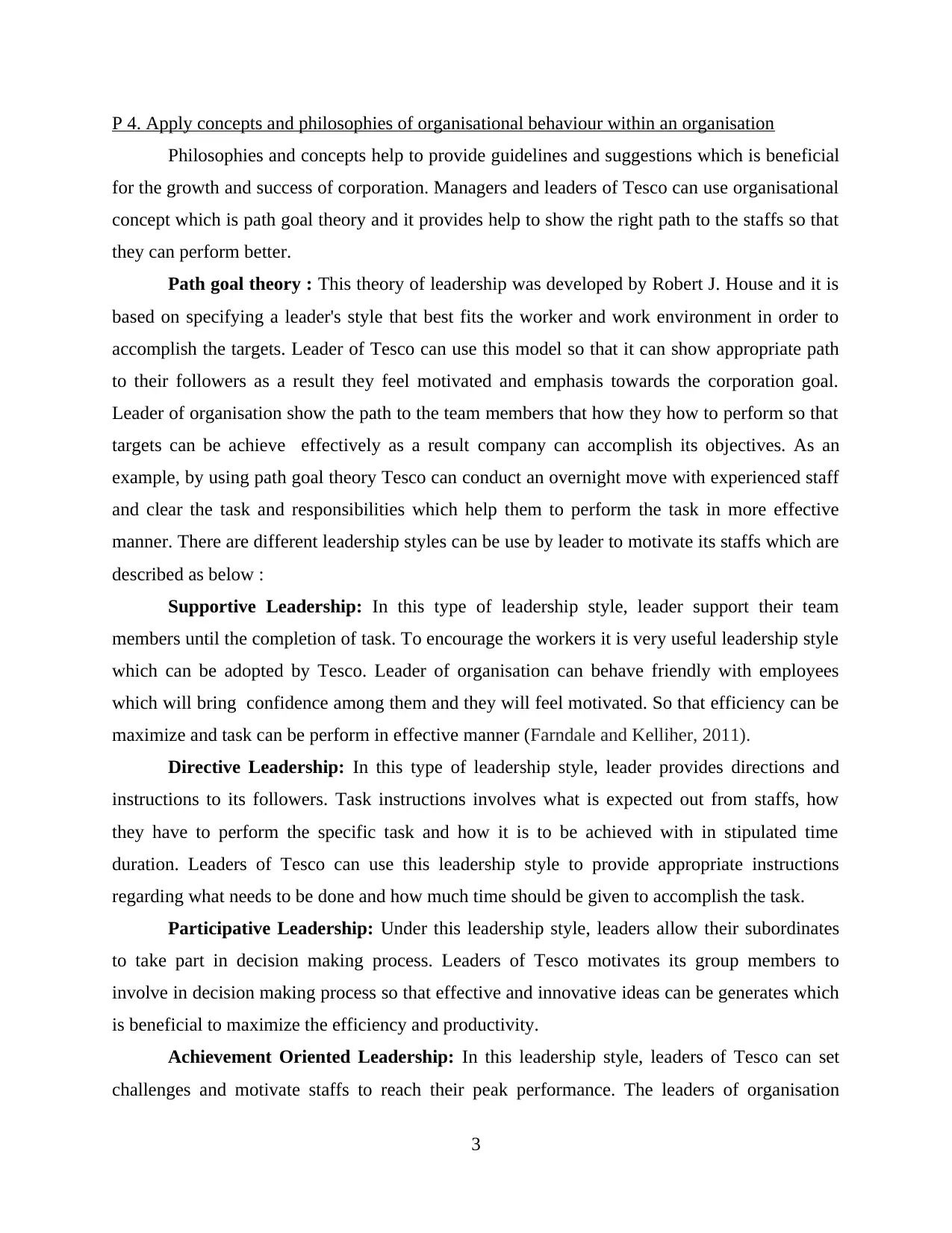
P 4. Apply concepts and philosophies of organisational behaviour within an organisation
Philosophies and concepts help to provide guidelines and suggestions which is beneficial
for the growth and success of corporation. Managers and leaders of Tesco can use organisational
concept which is path goal theory and it provides help to show the right path to the staffs so that
they can perform better.
Path goal theory : This theory of leadership was developed by Robert J. House and it is
based on specifying a leader's style that best fits the worker and work environment in order to
accomplish the targets. Leader of Tesco can use this model so that it can show appropriate path
to their followers as a result they feel motivated and emphasis towards the corporation goal.
Leader of organisation show the path to the team members that how they how to perform so that
targets can be achieve effectively as a result company can accomplish its objectives. As an
example, by using path goal theory Tesco can conduct an overnight move with experienced staff
and clear the task and responsibilities which help them to perform the task in more effective
manner. There are different leadership styles can be use by leader to motivate its staffs which are
described as below :
Supportive Leadership: In this type of leadership style, leader support their team
members until the completion of task. To encourage the workers it is very useful leadership style
which can be adopted by Tesco. Leader of organisation can behave friendly with employees
which will bring confidence among them and they will feel motivated. So that efficiency can be
maximize and task can be perform in effective manner (Farndale and Kelliher, 2011).
Directive Leadership: In this type of leadership style, leader provides directions and
instructions to its followers. Task instructions involves what is expected out from staffs, how
they have to perform the specific task and how it is to be achieved with in stipulated time
duration. Leaders of Tesco can use this leadership style to provide appropriate instructions
regarding what needs to be done and how much time should be given to accomplish the task.
Participative Leadership: Under this leadership style, leaders allow their subordinates
to take part in decision making process. Leaders of Tesco motivates its group members to
involve in decision making process so that effective and innovative ideas can be generates which
is beneficial to maximize the efficiency and productivity.
Achievement Oriented Leadership: In this leadership style, leaders of Tesco can set
challenges and motivate staffs to reach their peak performance. The leaders of organisation
3
Philosophies and concepts help to provide guidelines and suggestions which is beneficial
for the growth and success of corporation. Managers and leaders of Tesco can use organisational
concept which is path goal theory and it provides help to show the right path to the staffs so that
they can perform better.
Path goal theory : This theory of leadership was developed by Robert J. House and it is
based on specifying a leader's style that best fits the worker and work environment in order to
accomplish the targets. Leader of Tesco can use this model so that it can show appropriate path
to their followers as a result they feel motivated and emphasis towards the corporation goal.
Leader of organisation show the path to the team members that how they how to perform so that
targets can be achieve effectively as a result company can accomplish its objectives. As an
example, by using path goal theory Tesco can conduct an overnight move with experienced staff
and clear the task and responsibilities which help them to perform the task in more effective
manner. There are different leadership styles can be use by leader to motivate its staffs which are
described as below :
Supportive Leadership: In this type of leadership style, leader support their team
members until the completion of task. To encourage the workers it is very useful leadership style
which can be adopted by Tesco. Leader of organisation can behave friendly with employees
which will bring confidence among them and they will feel motivated. So that efficiency can be
maximize and task can be perform in effective manner (Farndale and Kelliher, 2011).
Directive Leadership: In this type of leadership style, leader provides directions and
instructions to its followers. Task instructions involves what is expected out from staffs, how
they have to perform the specific task and how it is to be achieved with in stipulated time
duration. Leaders of Tesco can use this leadership style to provide appropriate instructions
regarding what needs to be done and how much time should be given to accomplish the task.
Participative Leadership: Under this leadership style, leaders allow their subordinates
to take part in decision making process. Leaders of Tesco motivates its group members to
involve in decision making process so that effective and innovative ideas can be generates which
is beneficial to maximize the efficiency and productivity.
Achievement Oriented Leadership: In this leadership style, leaders of Tesco can set
challenges and motivate staffs to reach their peak performance. The leaders of organisation
3
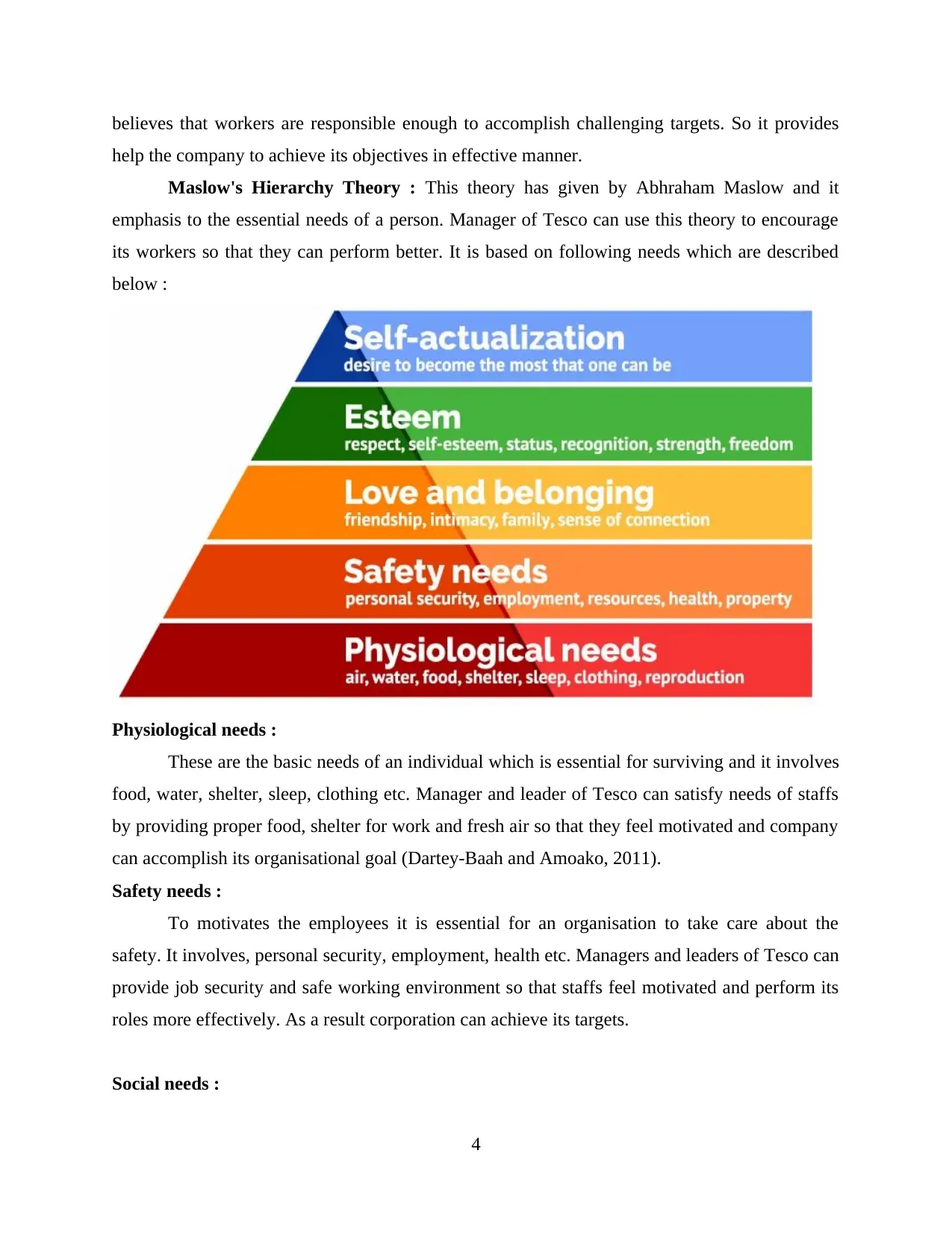
believes that workers are responsible enough to accomplish challenging targets. So it provides
help the company to achieve its objectives in effective manner.
Maslow's Hierarchy Theory : This theory has given by Abhraham Maslow and it
emphasis to the essential needs of a person. Manager of Tesco can use this theory to encourage
its workers so that they can perform better. It is based on following needs which are described
below :
Physiological needs :
These are the basic needs of an individual which is essential for surviving and it involves
food, water, shelter, sleep, clothing etc. Manager and leader of Tesco can satisfy needs of staffs
by providing proper food, shelter for work and fresh air so that they feel motivated and company
can accomplish its organisational goal (Dartey-Baah and Amoako, 2011).
Safety needs :
To motivates the employees it is essential for an organisation to take care about the
safety. It involves, personal security, employment, health etc. Managers and leaders of Tesco can
provide job security and safe working environment so that staffs feel motivated and perform its
roles more effectively. As a result corporation can achieve its targets.
Social needs :
4
help the company to achieve its objectives in effective manner.
Maslow's Hierarchy Theory : This theory has given by Abhraham Maslow and it
emphasis to the essential needs of a person. Manager of Tesco can use this theory to encourage
its workers so that they can perform better. It is based on following needs which are described
below :
Physiological needs :
These are the basic needs of an individual which is essential for surviving and it involves
food, water, shelter, sleep, clothing etc. Manager and leader of Tesco can satisfy needs of staffs
by providing proper food, shelter for work and fresh air so that they feel motivated and company
can accomplish its organisational goal (Dartey-Baah and Amoako, 2011).
Safety needs :
To motivates the employees it is essential for an organisation to take care about the
safety. It involves, personal security, employment, health etc. Managers and leaders of Tesco can
provide job security and safe working environment so that staffs feel motivated and perform its
roles more effectively. As a result corporation can achieve its targets.
Social needs :
4
⊘ This is a preview!⊘
Do you want full access?
Subscribe today to unlock all pages.

Trusted by 1+ million students worldwide
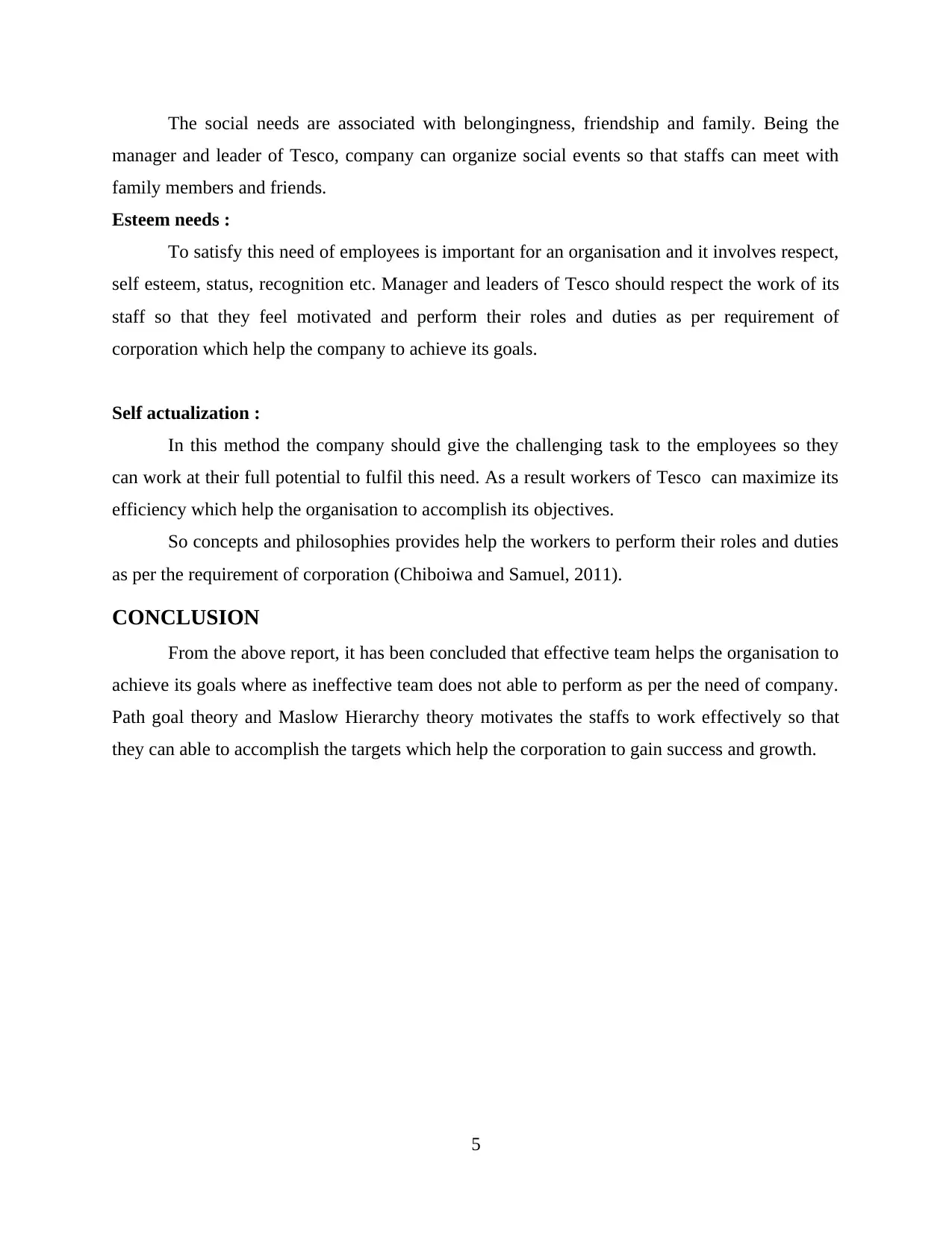
The social needs are associated with belongingness, friendship and family. Being the
manager and leader of Tesco, company can organize social events so that staffs can meet with
family members and friends.
Esteem needs :
To satisfy this need of employees is important for an organisation and it involves respect,
self esteem, status, recognition etc. Manager and leaders of Tesco should respect the work of its
staff so that they feel motivated and perform their roles and duties as per requirement of
corporation which help the company to achieve its goals.
Self actualization :
In this method the company should give the challenging task to the employees so they
can work at their full potential to fulfil this need. As a result workers of Tesco can maximize its
efficiency which help the organisation to accomplish its objectives.
So concepts and philosophies provides help the workers to perform their roles and duties
as per the requirement of corporation (Chiboiwa and Samuel, 2011).
CONCLUSION
From the above report, it has been concluded that effective team helps the organisation to
achieve its goals where as ineffective team does not able to perform as per the need of company.
Path goal theory and Maslow Hierarchy theory motivates the staffs to work effectively so that
they can able to accomplish the targets which help the corporation to gain success and growth.
5
manager and leader of Tesco, company can organize social events so that staffs can meet with
family members and friends.
Esteem needs :
To satisfy this need of employees is important for an organisation and it involves respect,
self esteem, status, recognition etc. Manager and leaders of Tesco should respect the work of its
staff so that they feel motivated and perform their roles and duties as per requirement of
corporation which help the company to achieve its goals.
Self actualization :
In this method the company should give the challenging task to the employees so they
can work at their full potential to fulfil this need. As a result workers of Tesco can maximize its
efficiency which help the organisation to accomplish its objectives.
So concepts and philosophies provides help the workers to perform their roles and duties
as per the requirement of corporation (Chiboiwa and Samuel, 2011).
CONCLUSION
From the above report, it has been concluded that effective team helps the organisation to
achieve its goals where as ineffective team does not able to perform as per the need of company.
Path goal theory and Maslow Hierarchy theory motivates the staffs to work effectively so that
they can able to accomplish the targets which help the corporation to gain success and growth.
5
Paraphrase This Document
Need a fresh take? Get an instant paraphrase of this document with our AI Paraphraser
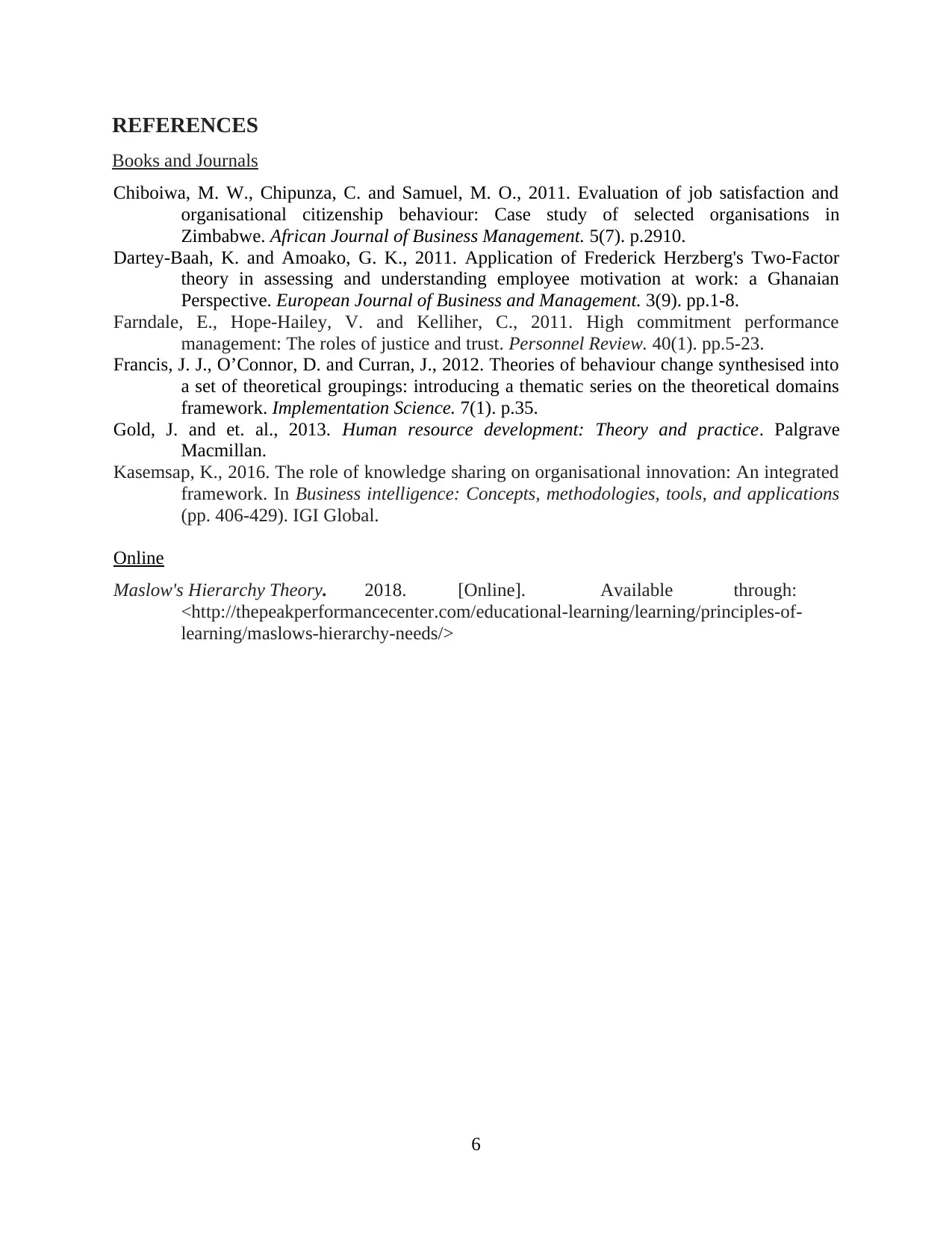
REFERENCES
Books and Journals
Chiboiwa, M. W., Chipunza, C. and Samuel, M. O., 2011. Evaluation of job satisfaction and
organisational citizenship behaviour: Case study of selected organisations in
Zimbabwe. African Journal of Business Management. 5(7). p.2910.
Dartey-Baah, K. and Amoako, G. K., 2011. Application of Frederick Herzberg's Two-Factor
theory in assessing and understanding employee motivation at work: a Ghanaian
Perspective. European Journal of Business and Management. 3(9). pp.1-8.
Farndale, E., Hope-Hailey, V. and Kelliher, C., 2011. High commitment performance
management: The roles of justice and trust. Personnel Review. 40(1). pp.5-23.
Francis, J. J., O’Connor, D. and Curran, J., 2012. Theories of behaviour change synthesised into
a set of theoretical groupings: introducing a thematic series on the theoretical domains
framework. Implementation Science. 7(1). p.35.
Gold, J. and et. al., 2013. Human resource development: Theory and practice. Palgrave
Macmillan.
Kasemsap, K., 2016. The role of knowledge sharing on organisational innovation: An integrated
framework. In Business intelligence: Concepts, methodologies, tools, and applications
(pp. 406-429). IGI Global.
Online
Maslow's Hierarchy Theory. 2018. [Online]. Available through:
<http://thepeakperformancecenter.com/educational-learning/learning/principles-of-
learning/maslows-hierarchy-needs/>
6
Books and Journals
Chiboiwa, M. W., Chipunza, C. and Samuel, M. O., 2011. Evaluation of job satisfaction and
organisational citizenship behaviour: Case study of selected organisations in
Zimbabwe. African Journal of Business Management. 5(7). p.2910.
Dartey-Baah, K. and Amoako, G. K., 2011. Application of Frederick Herzberg's Two-Factor
theory in assessing and understanding employee motivation at work: a Ghanaian
Perspective. European Journal of Business and Management. 3(9). pp.1-8.
Farndale, E., Hope-Hailey, V. and Kelliher, C., 2011. High commitment performance
management: The roles of justice and trust. Personnel Review. 40(1). pp.5-23.
Francis, J. J., O’Connor, D. and Curran, J., 2012. Theories of behaviour change synthesised into
a set of theoretical groupings: introducing a thematic series on the theoretical domains
framework. Implementation Science. 7(1). p.35.
Gold, J. and et. al., 2013. Human resource development: Theory and practice. Palgrave
Macmillan.
Kasemsap, K., 2016. The role of knowledge sharing on organisational innovation: An integrated
framework. In Business intelligence: Concepts, methodologies, tools, and applications
(pp. 406-429). IGI Global.
Online
Maslow's Hierarchy Theory. 2018. [Online]. Available through:
<http://thepeakperformancecenter.com/educational-learning/learning/principles-of-
learning/maslows-hierarchy-needs/>
6
1 out of 8
Related Documents
Your All-in-One AI-Powered Toolkit for Academic Success.
+13062052269
info@desklib.com
Available 24*7 on WhatsApp / Email
![[object Object]](/_next/static/media/star-bottom.7253800d.svg)
Unlock your academic potential
Copyright © 2020–2025 A2Z Services. All Rights Reserved. Developed and managed by ZUCOL.





